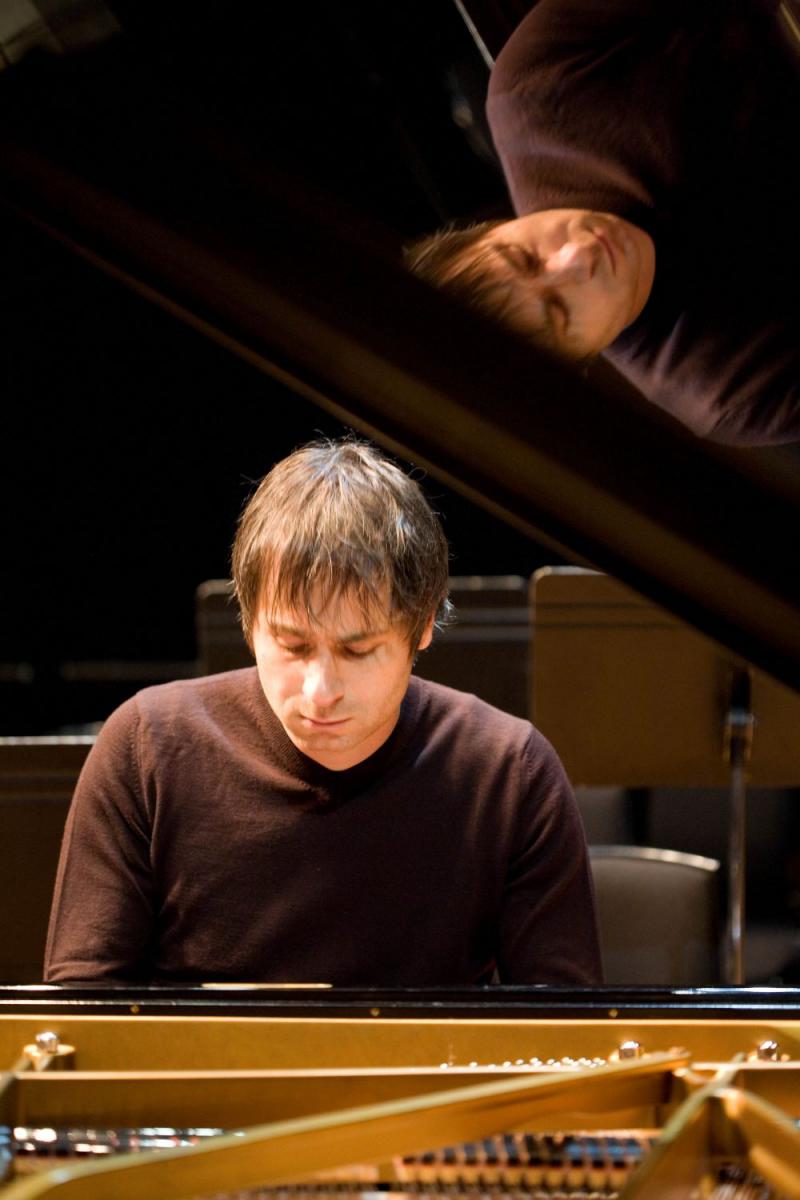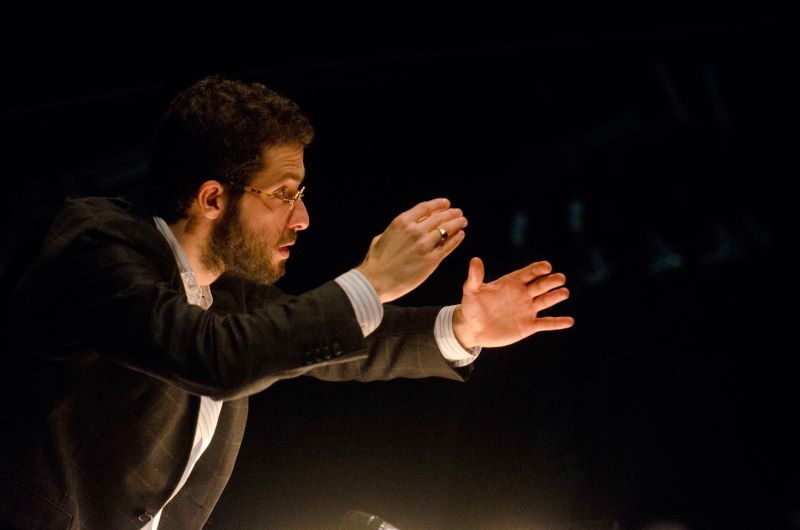Anderszewski, CBSO, Wellber, Symphony Hall Birmingham review - grandeur in restraint | reviews, news & interviews
Anderszewski, CBSO, Wellber, Symphony Hall Birmingham review - grandeur in restraint
Anderszewski, CBSO, Wellber, Symphony Hall Birmingham review - grandeur in restraint
Mozartian Bartók and Bruckner with itchy feet, as Omer Meir Wellber saves the day

No orchestra wants its conductor to cancel in the week of a concert.
And of course – always worth the price of admission – we still had Piotr Anderszewski as soloist in Bartok’s Third Piano Concerto. Wellber’s opening orchestral shimmer had an electrical charge to it: a sound that had an unquestionable presence in the hall and a sign that this performance was to be a dialogue as much as a matter of colour and atmosphere. Anderszewski declaimed his opening melody as if improvising; the movement that followed was a thing of clear edges, bold primary colours and a Mozartian sense of proportion, vividly articulated by a particularly plangent-sounding woodwind section and Anderszewski’s way of admitting just the tiniest suggestion of a lift at the end of a phrase.
In the Adagio religioso, too, Wellber gently teased out the texture of the opening string chorale – so often played at a breathless, homogenous whisper, but here very much alive and moving, with the cellos and basses softly tugging the music forward. The stillness that surrounded Anderszewski’s responses was all the more profound because of it: he placed lucid, luminous chords directly into the silence as if he was setting jewels into snow. And he never appeared to break a sweat in the finale, powering through thunderous double-octaves in perfect step with Wellber’s buoyant, whirling dance rhythms. Should it really look this easy? I just know that the final, headlong bars – the ones that the dying Bartók only sketched, leaving the orchestration to Tibor Serly – sounded as purposeful as they were exultant.
Wellber (pictured above, by Tato Baeza) carried that same control and sense of purpose, into Bruckner’s Sixth Symphony. No suggestion of a regimented march rhythm here: the violins’ opening pulse was like a firing synapse, as the main theme accelerated from a standing start to a genuinely thrilling momentum. That opening burst of energy charged the whole performance; the strings almost seeming to swing their second subject forward over pizzicato basses, and the thunderclap of Matthew Hardy’s timpani signalling successively more massive brass build-ups. With the timpani behind the first violins, facing off against the basses, and the brass forming an unbroken wall across the back of the orchestra, Bruckner’s monumental climaxes were as black toned and weighty as any Wagnerite could have wished.
And yet there was plenty of enchantment here: the rich, singing intensity of the strings at the start of the Adagio, Marie-Christine Zupancic’s sunlit flute soaring like the Woodbird over the outer movements’ more Siegfried-like rustlings, and Wellber’s sometimes poignant, sometimes frustrating way of letting a violin phrase blossom only to sweep the rest of the orchestra onwards and out from under their feet. With nervous energy in every bar, as well as an absolute refusal to indulge in bombast, the final ascent – resplendent as it was, with the CBSO’s horns punching for the heavens – felt like something more provisional than a grand entry into Valhalla. But the audience cheered anyway: perhaps in recognition that while more romantic visions of Bruckner are certainly available, Wellber had given us something of intelligence, integrity and real - if sometimes troubling – beauty.
rating
Share this article
Add comment
The future of Arts Journalism
You can stop theartsdesk.com closing!
We urgently need financing to survive. Our fundraising drive has thus far raised £49,000 but we need to reach £100,000 or we will be forced to close. Please contribute here: https://gofund.me/c3f6033d
And if you can forward this information to anyone who might assist, we’d be grateful.

Subscribe to theartsdesk.com
Thank you for continuing to read our work on theartsdesk.com. For unlimited access to every article in its entirety, including our archive of more than 15,000 pieces, we're asking for £5 per month or £40 per year. We feel it's a very good deal, and hope you do too.
To take a subscription now simply click here.
And if you're looking for that extra gift for a friend or family member, why not treat them to a theartsdesk.com gift subscription?
more Classical music
 Appl, Levickis, Wigmore Hall review - fun to the fore in cabaret and show songs
A relaxed evening of light-hearted fare, with the accordion offering unusual colours
Appl, Levickis, Wigmore Hall review - fun to the fore in cabaret and show songs
A relaxed evening of light-hearted fare, with the accordion offering unusual colours
 Lammermuir Festival 2025, Part 2 review - from the soaringly sublime to the zoologically ridiculous
Bigger than ever, and the quality remains astonishingly high
Lammermuir Festival 2025, Part 2 review - from the soaringly sublime to the zoologically ridiculous
Bigger than ever, and the quality remains astonishingly high
 BBC Proms: Ehnes, Sinfonia of London, Wilson review - aspects of love
Sensuous Ravel, and bittersweet Bernstein, on an amorous evening
BBC Proms: Ehnes, Sinfonia of London, Wilson review - aspects of love
Sensuous Ravel, and bittersweet Bernstein, on an amorous evening
 Presteigne Festival 2025 review - new music is centre stage in the Welsh Marches
Music by 30 living composers, with Eleanor Alberga topping the bill
Presteigne Festival 2025 review - new music is centre stage in the Welsh Marches
Music by 30 living composers, with Eleanor Alberga topping the bill
 Lammermuir Festival 2025 review - music with soul from the heart of East Lothian
Baroque splendour, and chamber-ensemble drama, amid history-haunted lands
Lammermuir Festival 2025 review - music with soul from the heart of East Lothian
Baroque splendour, and chamber-ensemble drama, amid history-haunted lands
 BBC Proms: Steinbacher, RPO, Petrenko / Sternath, BBCSO, Oramo review - double-bill mixed bag
Young pianist shines in Grieg but Bliss’s portentous cantata disappoints
BBC Proms: Steinbacher, RPO, Petrenko / Sternath, BBCSO, Oramo review - double-bill mixed bag
Young pianist shines in Grieg but Bliss’s portentous cantata disappoints
 theartsdesk at the Lahti Sibelius Festival - early epics by the Finnish master in context
Finnish heroes meet their Austro-German counterparts in breathtaking interpretations
theartsdesk at the Lahti Sibelius Festival - early epics by the Finnish master in context
Finnish heroes meet their Austro-German counterparts in breathtaking interpretations
 Classical CDs: Sleigh rides, pancakes and cigars
Two big boxes, plus new music for brass and a pair of clarinet concertos
Classical CDs: Sleigh rides, pancakes and cigars
Two big boxes, plus new music for brass and a pair of clarinet concertos
 Waley-Cohen, Manchester Camerata, Pether, Whitworth Art Gallery, Manchester review - premiere of no ordinary violin concerto
Images of maternal care inspired by Hepworth and played in a gallery setting
Waley-Cohen, Manchester Camerata, Pether, Whitworth Art Gallery, Manchester review - premiere of no ordinary violin concerto
Images of maternal care inspired by Hepworth and played in a gallery setting
 BBC Proms: Barruk, Norwegian Chamber Orchestra, Kuusisto review - vague incantations, precise laments
First-half mix of Sámi songs and string things falters, but Shostakovich scours the soul
BBC Proms: Barruk, Norwegian Chamber Orchestra, Kuusisto review - vague incantations, precise laments
First-half mix of Sámi songs and string things falters, but Shostakovich scours the soul
 BBC Proms: Alexander’s Feast, Irish Baroque Orchestra, Whelan review - rapturous Handel fills the space
Pure joy, with a touch of introspection, from a great ensemble and three superb soloists
BBC Proms: Alexander’s Feast, Irish Baroque Orchestra, Whelan review - rapturous Handel fills the space
Pure joy, with a touch of introspection, from a great ensemble and three superb soloists
 BBC Proms: Moore, LSO, Bancroft review - the freshness of morning wind and brass
English concert band music...and an outlier
BBC Proms: Moore, LSO, Bancroft review - the freshness of morning wind and brass
English concert band music...and an outlier

Comments
I probably wasn't the only
Does anybody know what Piotr
I'm afraid I've no idea: